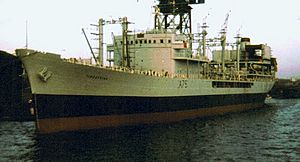RFA Tidespring (A75) facts for kids
 |
|
Quick facts for kids History |
|
|---|---|
| Name | RFA Tidespring |
| Ordered | 28 February 1961 |
| Builder | Hawthorn Leslie and Company |
| Laid down | 24 July 1961 |
| Launched | 3 May 1962 |
| Commissioned | 18 January 1963 |
| Decommissioned | 13 December 1991 |
| Identification | IMO number: 5361033 |
| Fate | Scrapped 1992 |
| General characteristics | |
| Class and type | Tide-class replenishment oiler |
| Displacement | 27,400 long tons (27,840 t) |
| Length | 583 ft 8 in (177.90 m) |
| Beam | 71 ft 3 in (21.72 m) |
| Draught | 32 ft 1 in (9.78 m) |
| Propulsion | 2 × Foster Wheeler watertube steam boilers, 2 × Parmetrada steam turbines, double reduction gearbox, single shaft |
| Speed | 17 knots (20 mph; 31 km/h) |
| Aircraft carried | 3 × Westland Wessex helicopters |
| Service record | |
| Operations: | Falklands War |
RFA Tidespring (A75) was a special kind of ship called a replenishment oiler. She belonged to the Royal Fleet Auxiliary (RFA), which supports the Royal Navy. Her main job was to carry fuel and supplies to other ships at sea. This allowed warships to stay at sea longer without needing to return to port.
Tidespring served for a long time, starting in 1963. She was an important part of the RFA fleet for nearly 30 years.
Contents
Tidespring in the Falklands War
Tidespring played a key role in the Falklands War in 1982. This conflict was fought between Argentina and the United Kingdom.
Helping in South Georgia
One of her most important missions was helping to retake South Georgia. This island is located in the South Atlantic Ocean. During this operation, Tidespring carried a group of soldiers called M Company of 42 Commando Royal Marines. These marines were highly trained and ready for action.
Supporting the Troops
The ship also helped by holding prisoners of war. These were soldiers captured during the fighting. Tidespring provided a safe place for them after they were taken.
A Ship's Extended Life
Before the Falklands War, Tidespring was planned to stop service in 1982. However, because she was so useful during the conflict, her service was extended. She continued to serve for another ten years after the war.
End of Service
After her long and busy career, Tidespring was officially taken out of service in December 1991. She then began her final journey.
Journey to the Scrapyard
On March 20, 1992, Tidespring was towed from Portsmouth, England. She traveled all the way to Alang, India. This place is known for its ship-breaking yards. She arrived there on July 2, 1992, and was taken apart for scrap metal.

